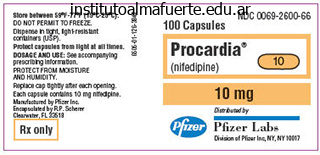



Precautions:
Uses:
Procardia is primarily used for the therapy of angina. It is efficient in relieving chest pain brought on by coronary artery disease, a medical situation the place the arteries that supply blood and oxygen to the guts turn into slender or blocked. Procardia helps to stop angina attacks by stress-free the blood vessels, which reduces the workload of the center and will increase blood move to the center. It can be used to deal with hypertension, also called hypertension.
Effectiveness:
Before taking Procardia, you will need to inform your doctor of any pre-existing medical conditions, allergies, and drugs you're presently taking. Procardia might work together with certain medication, together with beta-blockers, digoxin, and a few antibiotics. It can be essential to avoid consuming grapefruit or grapefruit juice whereas taking Procardia, as it might enhance the amount of medication in your bloodstream and trigger undesirable unwanted effects. Procardia is not beneficial to be used throughout being pregnant or breastfeeding.
Procardia has been proven to be effective within the therapy of angina. In a study performed by the University of California, Procardia was found to considerably decrease the frequency and severity of angina assaults. It was additionally proven to improve exercise tolerance and increase blood flow to the guts. Additionally, Procardia has been discovered to be as effective as different generally prescribed drugs for angina, such as beta-blockers and calcium channel blockers.
As with any treatment, there may be unwanted effects related to using Procardia. The most typical unwanted side effects are delicate and include dizziness, headache, flushing, and nausea. These symptoms are usually temporary and will subside because the body adjusts to the medicine. More severe unwanted effects, though uncommon, might include low blood stress, irregular heartbeat, and swelling of the ankles or feet. In some circumstances, Procardia may worsen pre-existing situations, corresponding to coronary heart failure or liver disease. It is important to consult a doctor if any concerning or persistent side effects happen.
Side Effects:
In conclusion, Procardia is a commonly prescribed treatment for the treatment of angina. It has been proven to successfully reduce the frequency and severity of angina attacks and improve exercise tolerance. However, as with every medicine, there could also be potential unwanted facet effects and precautions that have to be taken. It is important to seek the advice of a physician earlier than beginning Procardia and to carefully observe dosage directions. Procardia, when used appropriately, is usually a extremely efficient remedy for angina, offering reduction and improving the quality of life for many who undergo from this situation.
Procardia, also called nifedipine, is a prescription medicine generally used for the treatment of angina. Angina is a kind of chest ache that happens when the heart does not receive enough oxygen-rich blood. This pain can be severe and is usually described as a tightness, stress, or squeezing sensation in the chest. Procardia works by relaxing the blood vessels, allowing more blood and oxygen to move to the center. This article will discuss the makes use of, effectiveness, unwanted effects, and precautions of utilizing Procardia for angina.
Examination of the nose and palate characteristically reveals black, necrotic mucosa, a smear of which demonstrates branching hyphae. Without treatment, the infection quickly invades the intracranial space, resulting in meningitis, brain abscess, and death usually within days to weeks. It consists of reversing the underlying immunosuppression if possible, administration of intravenous antifungal agents (including amphotericin B, caspofungin, and/or posaconazole) and surgical debridement. A dermoid cyst contains epithelial structures such as keratin, hair, and even sometimes teeth, while an epidermoid cyst is filled with keratin but lacks dermal appendages. The 610 contents of either type of cyst can incite a severe inflammatory reaction if liberated into the orbit. Cysts that are within the orbit typically occur in the superior temporal quadrant and do not present until adulthood. En-bloc surgical removal with preservation of the cyst wall during surgery is the treatment of choice. Preferred treatment is endoscopic sinus surgery performed by otolaryngology to marsupilize the cyst and reestablish sinus drainage. The resultant fluctuant mass in the superior medial orbit typically enlarges with Valsalva maneuver. Most cases are present at birth, but those arising from the sphenoid bone may not become apparent until adolescence.
Procardia 30mg